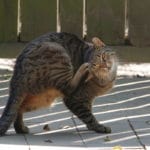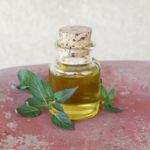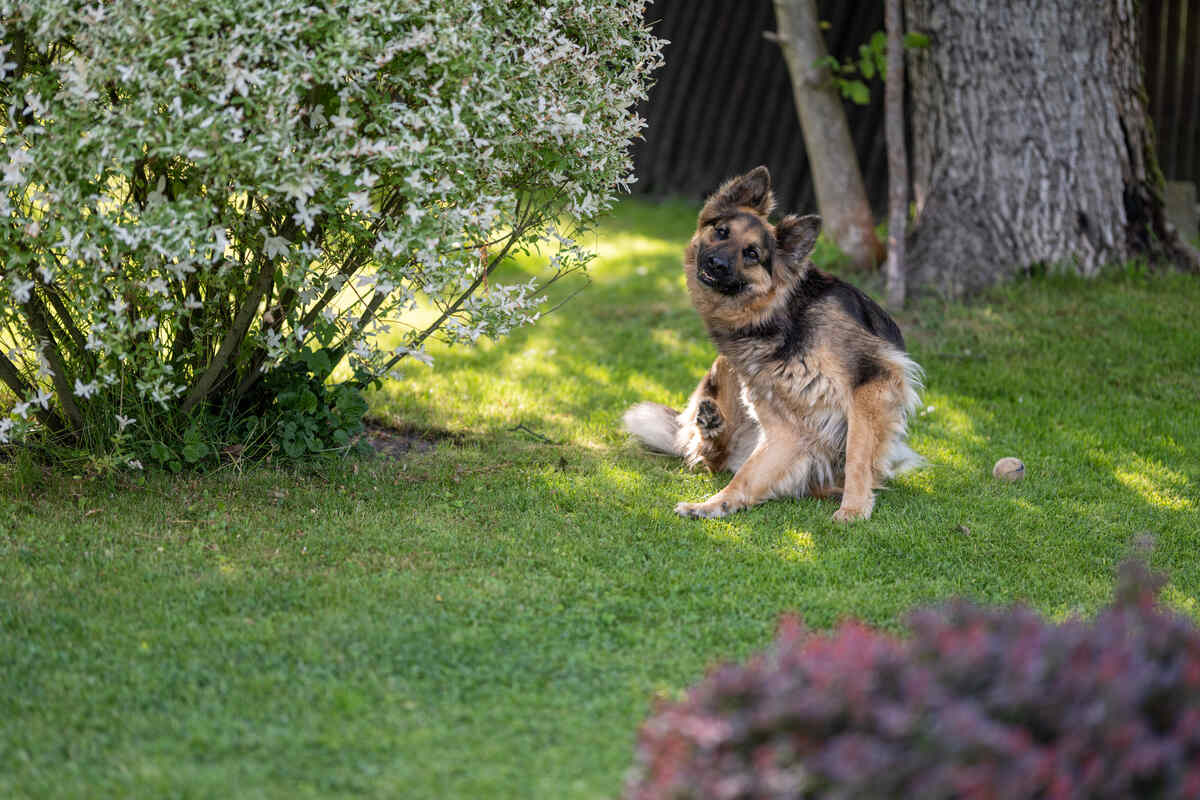
To get rid of fleas in your yard, start by cleaning it (e.g., mow the lawn, trim the shrubs, and remove debris), and then continue with natural flea treatments.
If cedar chips, nematodes, diatomaceous earth, and natural insecticides don’t work, carefully consider a synthetic flea killer. Keep in mind that you also need to treat the pets and the house to get a flea-free yard. It can take a few weeks, but it’s doable. We tell you how to approach each anti-flea solution for the best results.
Clean Up Yard Waste
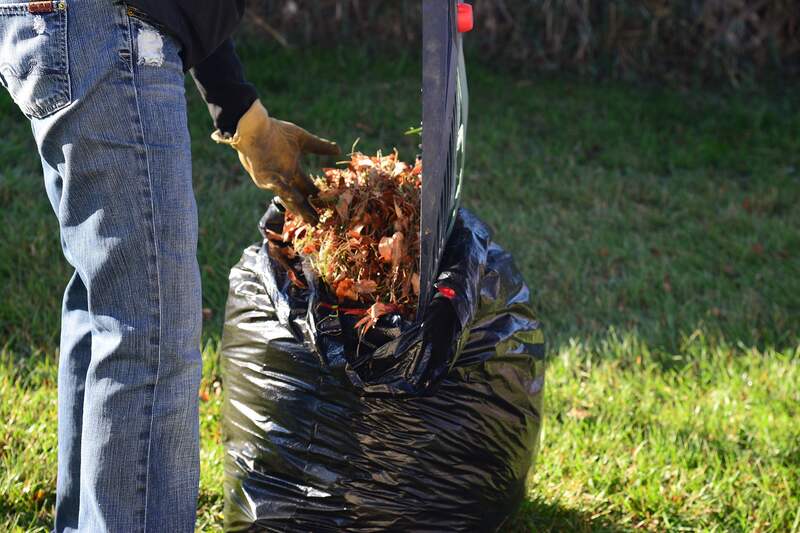
Every pile of yard waste on your property is a potential flea nest.
Flea larvae grow only in humid, warm, shady areas and rarely survive in open spaces. They avoid direct sunlight and die if exposed to dry air. The larvae hide under thick thatch, overgrown shrubs, and piles of debris, making those spots their breeding grounds.
To control a flea infestation and prevent a future one, make a habit of keeping the yard clear of debris:
- Rake the thick thatch and fallen leaves off the lawn
- Bag the piles of leaves and organic debris and put them in the garbage bin.
- Remove twigs, branches, and other yard waste.
- Take the outdoor furniture off the lawn and store it in the garage when not using it.
My tip: Compost piles provide a moist, dark, warm environment that can sustain fleas. Avoid adding organic debris to the compost if you suspect they are infested with these parasites.
Mow the Lawn
Tall grass keeps the soil moist and shaded and is an ideal hiding ground for fleas, ticks, ants, and mosquitoes.
An easy flea control strategy for your yard is to mow the lawn regularly and let more sun reach the soil and drive away the pests. How short should you mow? The regular mowing height recommended for your type of grass will do just fine.
Pay extra attention to lawn edges. Trim the plants along the fence, around the house foundation and garden shed. The fence and walls shade those spots and make them attractive to fleas.
Trim Hedges, Bushes, and Shrubs
Overgrown bushes, hedges and shrubs provide fleas with a moist, dark environment to shelter in.
You can manage the fleas in the yard more easily if you trim the shrubs. Here’s how to keep fleas away:
- Trim the hedges, shrubs, and bushes on your property.
- Remove the cuttings and the dead vegetation underneath the trimmed plants.
- Put the debris in a closed bag and take it straight to the garbage bin in case it harbors fleas.
Remove Standing Water and Fix Drainage Issues
The low spots in your yard where pools after rain or irrigation are magnets for flea-carrying wildlife and an ideal habitat for flea larvae to grow.
You can reduce fleas’ survival chances in your yard just by making sure there’s no standing water around. Here’s what you can do:
- Level low spots to prevent water pooling
- Fix drainage issues: dethatch and aerate the lawn, install French drains, or create a swale
- Clean and repair gutters to prevent rainwater from pooling near the house
- Remove old pots, tires, and any other object that can collect rainwater.
Mulch with Cedar Chips
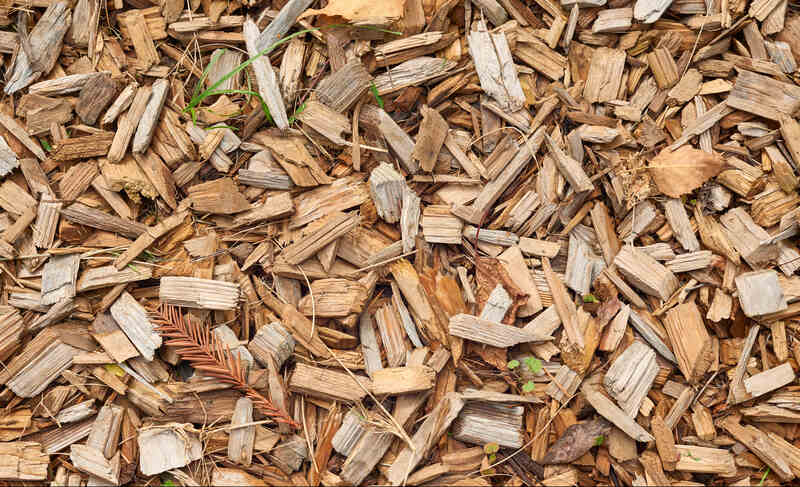
Cedar chips contain cedar oil, a well-known insect repellent used to control fleas and ticks.
Most types of mulch, such as grass clippings, straw, or tree bark, don’t repel fleas. Actually, in a thick enough layer, they provide a moist, shaded area for flea larvae to hide and grow. To keep fleas away from your yard, replace it with cedar chips.
To get the most of cedar chips flea repellent properties:
- Spread the chips in spots that attract fleas and where your pet cuddles (e.g., under the porch, under decks, around patios, and along the fence).
- Reapply every 4 to 6 weeks.
My tip: Don’t neglect to spread cedar chips underneath your shrubs, bushes, and hedges. That dark, damp area right near the soil is as comfortable as a bird’s nest and can harbor fleas.
Grow Flea-Repellent Plants
Flea-repellent plants have strong scents that fleas hate and avoid.
Another way to prevent fleas from infesting your yard is to grow repellent plants in areas that are typically attractive to fleas, such as:
- Around the porch and house foundation
- Around the patio, deck, or shed
- Along the fence
- Where your dog likes to cuddle during summer when looking for shade.
Common insect-repellent plants to consider include peppermint, lemongrass, lavender, rosemary, chrysanthemums, citronella, and pennyroyal.
Treat the Lawn with a Natural Insecticide
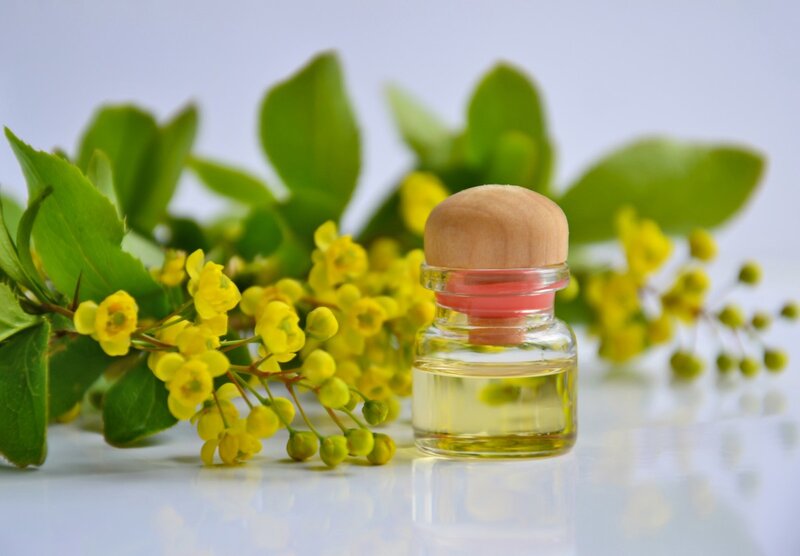
According to Dr. Michael Merchant, a retired urban entomologist at Texas AgriLife Extension Service, you don’t need to treat the entire yard for fleas.
“Outdoor spray treatments should focus on crawl spaces, bedding areas, sites under decks and shrubbery, and shady areas wherever your pets spend a lot of time,” says Dr. Merchant.
Kennels, dog houses, and dog runs are also often infested with fleas.
The best pest-safe flea killers to try are nematodes, diatomaceous earth, and insecticides made with essential oils.
Beneficial Nematodes
Nematodes are microscopic worms that infest flea larvae and pupae with deadly bacteria, killing them before they turn into adult fleas. They provide an effective natural method to get rid of fleas in outdoor spaces.
You can buy live nematodes from specialized websites (Arbico Organics), online stores (Amazon, Walmart), or local garden stores.
For best results, spread these flea predators early morning or late evening, when they are less exposed to heat and dryness. Water the area before application to moisten the soil. Mix the nematodes in the package with filtered, cool water (tap water has chlorine that can kill them) following label indications. Lightly water every other day to keep the soil moist, and do a second application one to two weeks after the first.
Diatomaceous Earth
Diatomaceous earth is a natural silica powder that desiccates the flea larvae and adult fleas. It kills the yard fleas in a few hours to a day, reducing the flea population.
The powder is inactive when wet, so apply diatomaceous earth only when the soil and vegetation are dry and there’s no rain forecast for the next 24 to 48 hours.
Reapply after four to six weeks or if it rains.
Note: This fine dust can irritate the skin, eyes, and respiratory tract if inhaled. Wear goggles, gloves, and long sleeves, and keep kids and pets away until the dust settles.
Essential Oils
Essential oils such as peppermint, cinnamon, citronella, and cedar oil can kill and repel fleas and are used in many natural flea sprays such as Wondercide, Cedarcide, and Might Mint. The solution is easy to apply using a garden hose and a sprinkler head.
These natural ingredients degrade quickly, so you’ll need to reapply the flea spray once every 5-10 days (or after rain) until you control the infestation. A preventive application once every 35 to 40 days after the fleas are gone ensures they won’t come back.
Consider Synthetic Flea Treatments
Severe flea infestations are rare outdoors, but if it happens, you might need to apply a synthetic product.
Two types of flea treatments are most commonly used:
- Insect growth regulators (IGRs), such as pyriproxifen (e.g. Nixlo IGR), prevent the flea eggs from hatching and the larvae from growing, breaking the flea life cycle. IGRs don’t kill flea adults.
- Adulticides (kill adult fleas) attack the adult fleas’ nervous system and cause paralyzes and death. Pyrethroids, such as bifenthrin (e.g. Bifen LP), are common insecticides in this category.
You can contact the local Cooperative Extension Office or a pest control specialist to find out which product is best for your yard.
Note: Synthetic flea treatments are more toxic than natural options. Follow the application instructions carefully, wear protective clothing, and keep kids and pets away until the product is dry.
Evict Wildlife and Strays
To control the flea infestation in your yard, find and control the animal spreading the fleas.
Experts at the University of California Agricultural and Natural Resources say up to 80% or more of feral cats are infested with flea eggs or adult fleas. If you have a stray cat roaming around the yard, it’s probably your flea source.
Feral cats often hide under decks or sheds, in dense bushes, under piles of leaves, beneath tarps, and other dark corners where they can find shelter. You can trap and relocate the infested cat or treat it for fleas. Stray cats can be aggressive, so most times, it’s better to call animal control to handle them.
Other flea carriers to keep an eye out for include stray dogs and wild animals such as raccoons, rodents, opossums, rabbits, and skunks.
Keep in mind that the flea carrier might also be your pet.
Treat Your Pets
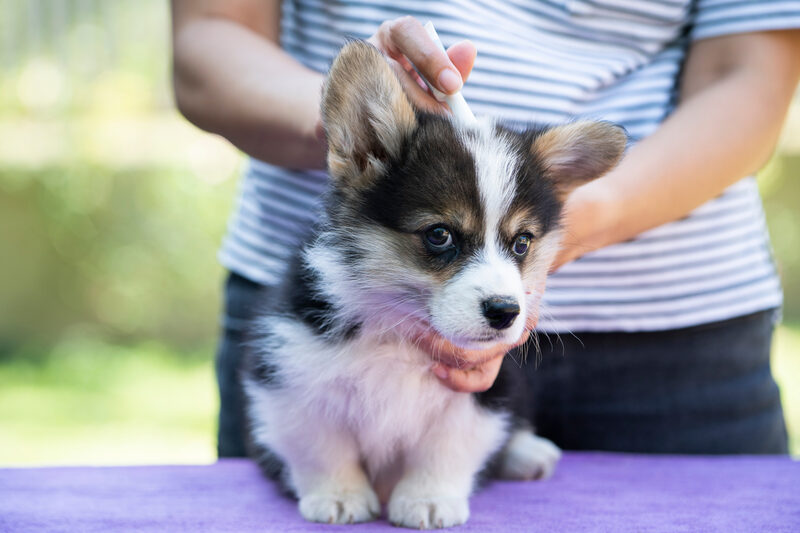
If your pets are protected against fleas year-round, they’ll also help reduce the fleas in your yard and home.
House dogs and cats that carry fleas become the main source of flea eggs and reinfest the yard when they go outside. A regular treatment (we treat the cats monthly, but it depends on the product) can ensure any flea that feeds on the pet dies and doesn’t get to lay eggs.
The most effective options are flea pills and “spot-on” medicine (Bravecto, Revolution, Frontline Plus, Nexgard). Flea shampoos and flea collars (e.g. Seresto flea collars) also work well. Talk to the veterinarian for a suitable flea treatment for your dog or cat.
FAQ
To know if you have fleas in the yard use the white socks test. Put on a pair of tall white socks and walk around the property. If they’re present, fleas will jump on your socks, looking for a blood meal.
A general recommendation is to spray once a week for a month to control the infestation and then once a month to prevent the fleas from reinfesting the yard.
Experts say it can take 3 to 8 weeks to eliminate a flea infestation. That is because it’s not only about killing the existing adult fleas. The infestation on a cat or a dog usually originates in the environment (indoors or outdoors), and it takes time to get rid of all the eggs, larvae, and pupae.
Fleas carry several parasites and diseases that can put your pet at risk, such as Mycoplasma haemofelis (which can cause severe anemia), tapeworms, cat scratch disease (CSD), and murine typhus. The more the pets are exposed to flea bites, the more are at risk of getting sick.
Enjoy a Flea-Free Lawn!
A flea infestation is the last thing you need to worry about in your busy week. Find a pest control company with LawnStarter, leave the flea problems to the pros, and enjoy a flea-free lawn with no effort on your part.
Want more free time and a perfect lawn? LawnStarter pros can also take care of lawn mowing, yard cleaning, leaf removal, and hedge trimming, keeping your yard neat and tidy.
Sources:
- Dryden, M.W. (2016, October). Challenges and Solutions to Flea Control. https://www.isvma.org/wp-content/uploads/2016/10/ChallengesandSolutionstoFleaControl.pdf
- Merchant, M. (n.d). Safer Flea Control. Texas A&M AgriLife Extension. https://citybugs.tamu.edu/factsheets/biting-stinging/others/ent-3001/
- UC Statewide IPM Program (2023, July). UC IPM Pest Notes: Feral
- Cats. UC ANR Publication 74178. https://ipm.ucanr.edu/legacy_assets/pdf/pestnotes/pnferalcats.pdf
LawnStarter participates in the Amazon Services LLC Associates Program, an affiliate advertising program. LawnStarter may earn revenue from products promoted in this article.
Main Image Credit: lapis2380 / Adobe Stock Free / License

